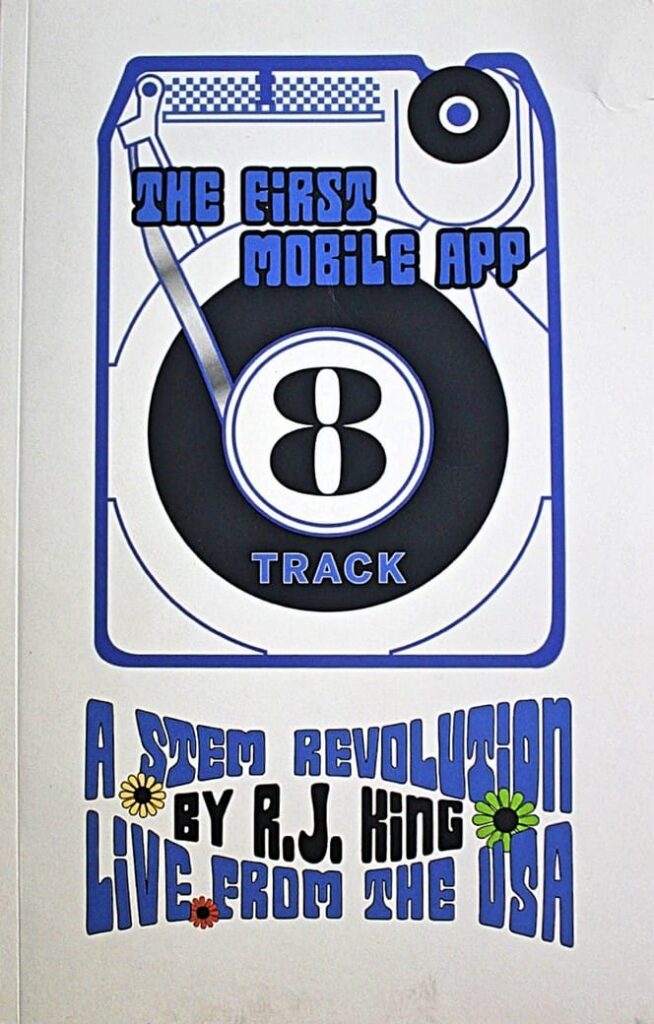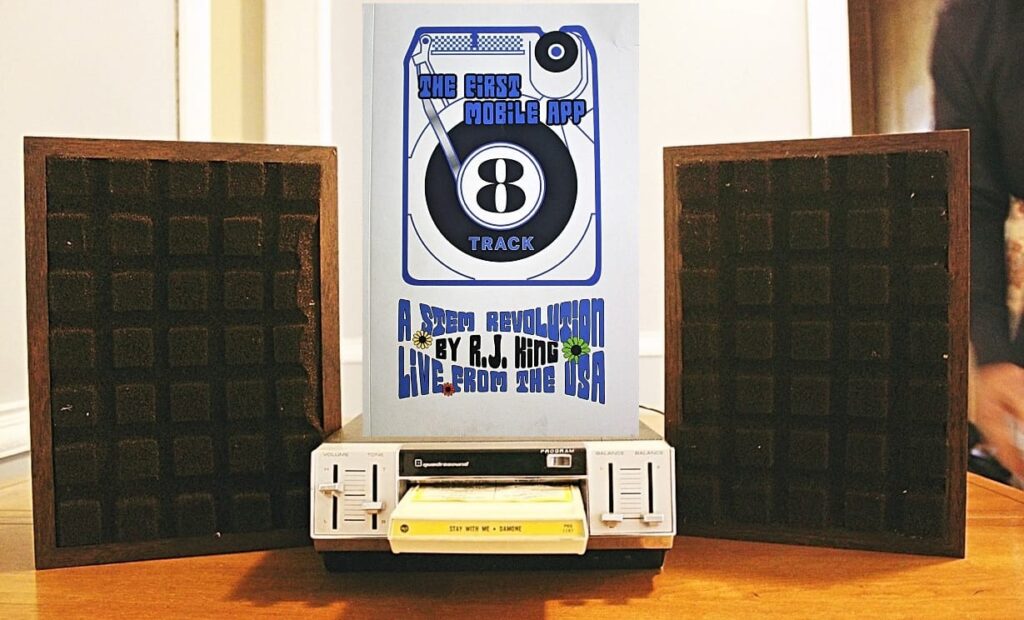
I’ve always loved Boston-Edison. This is a large residential Historic District in the geographic center of Detroit full of stately homes, wide boulevards, and old-fashioned streetlamps. Detroit author and DBusiness magazine editor RJ King moved to a beautiful three-story Colonial Revival here in 1994.
Sitting in RJ’s living room, we can hear the steam gently whooshing through the radiators. Soothing, it reminds of my Marpac Dohm sound machine, whose sonic white noise helps me sleep.
RJ is very welcoming, hospitable, and insightful. In terms of stories and hidden history, he has an eagle eye for tantalizing, overlooked, and underreported gems. A writing talent, RJ has penned over 6,000 articles at DBusiness and over 16 years for The Detroit News. Prolific at home, RJ has written four books. Never one to lollygag or dawdle, he’s also a licensed real estate agent!
We’re here discussing his fabulous new book, “8 Track: The First Mobile App,” published by Folktellers and Written in Detroit.

When publicly released in October 1965 by Ford Motor Co., the 8 Track tape player completely revolutionized in-car audio and how music in general was experienced by consumers.
It offered, for the first time, a mobile music experience in an industry dominated by AM Radio and record players.
Since then, the 8 Track, which essentially offered “album” cartridges, served to bootstrap the introduction of cassettes, followed by compact discs, and now downloads. Today, the medium has been largely forgotten as a fun and useful device in the ‘60s and ‘70s.
The last major release on 8 Track was in 1988 with Fleetwood Mac’s “Greatest Hits.”

Sure, from 2009-2014 there was an 8 Track museum run by Bucks Burnett in Deep Ellum, Texas.
And Barry Fone runs Barry’s 8 Track Repair Center in Prescott Valley, Ariz.
And don’t forget “Tracker Bob” Hiemenz. Bob owns the world’s largest 8 Track collection. Over 90,000 tapes and 700+ players are stored at his house in Quincy, Illinois. But for many people, especially those who postdate 8 Track mania, the true story is a quick trip back in life filled with nostalgia.
RJ’s new book is an incredibly detailed and well-researched story of Detroit and Ford Motor Co.’s pivotal role in the development and rollout of the 8 Track tape player.
Part hidden history, part business lesson, this is a story largely untold until now.
RJ King on His Book

“My older brother Patrick emailed me a speech that my dad, John P. King, had written in 1975 to celebrate the 10th anniversary of the 8 Track tape player. Until reading that email, I had no idea my dad was intimately involved in the development of 8 Track back when he was a product engineer at Ford.”
“Fascinated, I searched for a period history of 8 Track, and there was nothing. So I started researching my dad’s involvement, assembling a chronology, reading Billboard magazines every week from 1964 to 1980, and doing interviews with my dad and other key people whom he introduced me to.”
“I worked on the book on weekends, typing it up on my iMac, and about a year and a half later had a final product.”
“This book details the leap from stationary music to mobile music. The 8 Track really was the first mobile music app. Prior to its creation, you could only listen to music live, on a record player, or on AM radio. What Ford and Motorola did, using Bill Lear’s design which they modified, is they built a combined AM Radio and 8 Track tape player and it completely revolutionized music and car audio.”

“All four of the STEM disciplines (science, technology, engineering, math) were used to invent, launch, and sustain 8 Track. It was a big leap from the mono world to the stereo world. The 8 Track was a physical music playback system that allowed you to listen to songs without being present with the band. It was the introduction of ‘music to go.’”
“My dad was hired by Ford in January 1965, and the 8 Track was ready to go by October 1965. It was a rush program, to be sure. After Ford came out with 8 Track, Chrysler, and then GM, Volkswagen, and American Motors offered 8 Track. It was successful because it was a group effort.”
“Motorola designed the players, Lear made the cartridges, RCA contributed the music, and Ford installed the players into 1966 model year vehicles.”
“Initially, none of the record companies would license their music to 8 Track. But Bill Lear knew David Sarnoff, chairman at RCA Records, and they licensed 175 albums.”

“Then later, Motown Records in Detroit, licensed some of their catalog for it. And all the other record companies came on board, and by 1970 it was a $1 billion industry. Motown even let Lear’s team transfer the initial master record tracks from RCA to magnetic tape. Berry Gordy would sometimes come up and hang out on the third floor of Motown Records (which is a converted house on West Grand Blvd.), and the machine was only available after midnight.”
“What I want the reader to take-away is that forming a talented team and working together is key to the success of any project. You’ll also learn how vital it is to control your intellectual property, and how to launch a major industry from scratch, and take advantage of the good sales years and properly prepare for winding down the business, as 8 Track gave way to cassettes, and so on.”
RJ’s dad John P. King fills in the gaps
RJ calls his father on the phone. His dad, John P. King, is 85 years old. He grew up on Chicago’s west side on Jackson Boulevard near Garfield Park, until moving to Michigan in January 1965. He earned a master’s degree from the Illinois Institute of Technology, and he had magnetic tape background based on his early employment.
John started out as project engineer for the introduction of the 8 Track Tape Player, and wrote all the standards (and made sure everyone adhered to them).
He retired as Regional Manager of Asia Pacific and New Markets for Ford Customer Service Division in 1997, and today is active with FREE (Ford Retired Executive Engineers).
John says:
“The development of 8 Track was fast-tracked so we could make the 1966 model year. We all worked many extra hours to bring it to market in only nine months, which was unheard of.”
“Back then, I had what we called a ‘Sound-Off’ with Earl ‘Mad Man’ Muntz out at the Ford Assembly Plant (28801 South Wixom rd, Wixom, MI). Muntz acquired that nickname in Los Angeles when he had a used car business. He was the guy who invented the 4 Track tape player, and he had a flair for showmanship and self-promotion. He was trying to get all the automakers to go for his 4 Track.”
“The Sound-Off was held at the Ford Wixom Plant, where at that time they were building the Thunderbird and the Lincoln Continental. Well we had an audio test among a small group of Ford people and Muntz, and we pitted his 4 Track against our 8 Track tape player by doing a live demonstration.”
“I showed up with my 1963 Ford Fairlane wagon, but I had swapped out the factory speakers with six-by-nine-inch speakers front and rear, and I had installed a very new production 8 Track tape player. From there, it was obvious that the 8 Track sounded far better. What wasn’t obvious was that I had installed stereo speakers in my car.”

“One other funny story. Donald Frey, the guy who designed the Ford Mustang, lived near Pete Estes, who was vice president for General Motors. Don was the overall lead on 8 Track at Ford, and he asked if speakers could be mounted in the front grill of his car, and he wanted specially loud Motorola bullhorn speakers. The speakers were wired to Don’s 8 Track tape player in his car. At the time, Ford’s ad slogan was ‘Ford has a better idea.’ So every morning when he drove by Pete’s house, Don would blast that slogan with the music at full volume.”
“Later, in 1967, Don Frey had us do a sound comparison between the 8 Track Tape Player with the latest cassette tape. At that time, the fidelity of the 8 Track was superior. Another factor was you had to manually flip the cassette, where 8 Track was hands free. But eventually cassette won out as Lear, who owned the patents on 8 Track, sold them to Gates Rubber Co., and they failed to renew the patents in 1975. From there, the standards could not be maintained, and the industry started to introduce cheaper products.”
“A plus for cassette tapes was that it was much easier to record your own material. And the cassette was half the size of 8 Track. So we helped usher in cassettes, and then compact discs. When I retired from Ford in 1997, downloads were available, and you could see one day they would be readily available.”
Back to RJ.
RJ King Biography

“I have 6 sisters, 2 brothers, and I’m in the middle! (laughs) I have 3 sisters and 1 brother older, and also 3 sisters and 1 brother younger.”
“I’m editor of DBusiness magazine. Prior to that I was working at The Detroit News starting in 1990. I was on the business staff until I ran into Gail Fisher (now Gotthelf) while volunteering at a charity event during Super Bowl week in February 2006.”
“Gail worked for Hour Media and said the two owners, John Balardo and Stefan Wanczyk, were looking to start a business magazine. I came onboard and that’s how DBusiness was born.”

“Hour Media is based in Troy, Michigan. As a parent company, they own around 160 magazines, including Hour Detroit, DBusiness, Grand Rapids magazine, Grand Rapids Business Journal, and we have other magazines in Los Angeles, Sacramento, Minneapolis/St. Paul, Cincinnati, Atlanta, all throughout Florida, the Gulf Coast of Alabama, and more.”
“In general, I write one story per day for DBusiness Daily News and write about 7-10 stories per each issue of DBusiness magazine.”
“In terms of local restaurants, some favorites are Roman Village in Dearborn and also London Chop House and the Vertical Wine Bar, both in Detroit.”
Upcoming Developments

“We just introduced an audiobook version of my other book, ‘Detroit: Engine of America,’ available on Audible.”
“And I have a fifth book coming out in March 2021 called “Grounds for Freedom.” It’s an unbelievable true story about Andrew Niemczyk, a local inventor who has developed amazing machines and new technologies. Check out his website at Exlterra. ”
Buy RJ King’s 8 Track book here
https://www.amazon.com/Track-First-Mobile-Stem-Revolution/dp/B08FP4QJF1
Email RJ King
8 Track (and related audio) Timeline
*Most of this timeline was pieced together from information found in RJ’s book

- 1928-Motorola founded in Chicago. Bill Lear helped name the company.
- 1930-the Motorola car radio is invented
- 1935-RJ’s father John P. King born in Chicago
- 1948-Columbia Records introduces the LP
- 1949-RCA invents 45 RPM
- 1949-sales of the 1949 Ford help save the company’s fortunes
- 1952-endless loop tape cartridge invented
- 1954-George Eash invents the Fidelipac tape cartridge
- September 12, 1955-Chrysler agrees to install Peter Goldmark’s in-car record player (Columbia Records) after the automaker’s team in Highland Park, MI tests the prototype by driving on the nearby Davison Freeway.
- 1956-58-the Highway Hi-Fi in-car record player is featured in some Chrysler vehicles. It uses special 7-inch records called ‘ultra-microgroove.’ It was a big flop.
- 1959-closed loop tape players are used at nearly every AM radio station
- 1960-used car dealer Earl “Madman” Muntz invents the 4 track tape player
- 1961-Michiganian Larry Spitters founds Memorex in Silicon Valley
- 1962-the audio cassette is developed by Philips in Hasselt, Belgium
- 1963-Bill Lear, owner of 110 patents, invents the Lear Jet to be introduced in 1966
- October 1964-the 8-Track Stereophonic Tape Player is developed by Bill Lear and Richard Kraus at Lear Jet corporate HQ (Wichita, KS). Afterwards, they are built regularly at the Lear Jet Stereo-8 division (13131 Lyndon Ave, Detroit)
- January 1965-John P. King moves to Dearborn to work for Ford
- July 1965-Motorola begins production shipments of 8 Track tape players to Ford
- October 3rd, 1965-8 Track tape players are released to the general public thanks to Lear’s friendship with Henry Ford II (grandson of big Henry). They are released in the form of an AM radio with integrated 8 track tape player installed inside Ford vehicles.
- 1965-80 = 8 track is popular
- 1966 = Ford sells over 125,000 8 track players as an option (available on six models)
- Fall 1966-all Detroit automakers now offer 8-Track factory installation options
- April 1967-Gates Rubber Co. acquires a controlling interest in Lear Jet
- May 1967-Earl Muntz has his son Jim Muntz fly to Detroit and open Muntz CARtridge City (15278 Gratiot Ave, Detroit) to sell 4 track players and tapes
- 1969-Sinatrajobim 8 track tape (3,500 made but quickly recalled; only a handful not recalled). This is currently the rarest 8-Track, selling for upwards of $6,000
- September 1969-production of 8 Track tapes ceases at Lear’s Detroit plant. They move production down to twin plants in Tucson, AZ and Nogales, Mexico.
- December 1969-Lear’s company’s name is changed to the Gates Learjet Corp.
- 1970-RCA releases 40 Quad-8 tapes (Quadrasonic sound)
- 1971-GM and Chrysler start offering cassette tape player options in cars
- 1979-Sony and Philips join forces to create Red Book standards for Compact Disc Digital Audio
- 1979-Sony Walkman invented
- 1979-Ford introduces all-electronic AM/FM stereo radio with Quadrasonic 8 Track player. Knobs and buttons are replaced by a brand new digital display.
- October 1982-CD player Sony CDP-101 publicly released in Japan by Sony Philips
- April 1983-CDs become popular in USA as car manufactures install them
- October 1984-Terra Haute, IN = first US CD plant opens
- May 1985-CDs become insanely popular worldwide
- 1985-Sony Discman invented
- 1986-the Lincoln Town car has a CD player. This is the first factory-installed application in the domestic auto industry.
- 1988-CD sales eclipse vinyl
- November 1988-the last 8 track tape is made = Fleetwood Mac’s Greatest Hits
- 1991-CD sales eclipse cassettes
- 1999-Napster file sharing MP3s
- 2000-CD sales global peak (2.45 billion sold worldwide)
- 2001-Apple iPod
















